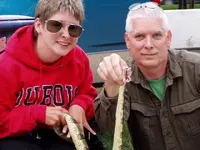Most Rattlesnake bites are "Dry Bites" in which little or no venom is injected. Rattlesnakes are very careful not to waste precious venom on a large animal/person it is not going to eat. Most bites where venom is injected is when a rattlesnake is surprised, for example when you reach under a rock, step on the snake, reach up on a rock ledge or lift your head over a ledge. Another situation where a rattlesnake will inject is when it is absolutely harassed, usually when being poked or picked up and it fears for its life. However when a rattlesnake is rattling and giving you a warning most of the strikes from the coiled position towards you are dry bites. They actually have the ability to control whether venom is excreted through the fangs. This is the reason why baby rattlesnakes are very dangerous, they do not have this ability to control their venom and always excrete venom on a bite. As far as the paramedic above said, the standard EMS Protocol for Paramedics in pre-hospital care is to immobilize the area of the bite, start an IV and transport. They do not apply tourniquets or make incisions, use local suction, etc. just get the patient to the hospital as soon as possible. The goal is to identify the snake if safely possible and start administering Antivenin (note the correct spelling). So if you suffer a bite from a rattlesnake in the wild, get to a safe place and call 911 immediately. Remove rings, watches, bracelets, etc., if bitten on the hand. Immobilize the area of the bite, remain calm and remember there is always the high probability that you were not injected with venom. If not able to call 911, the goal is to get to a hospital as soon as possible to have treatment started. To avoid being bitten, as others have said, wear snake boots, snake boots are better than snake chaps, chaps are better than nothing. Don't reach under anything that you can't completely see under. When climbing up or down rocks, be aware that rattlesnakes prefer rocky outcrops and rocky areas and avoid stepping or reaching anywhere that you can't see (especially when climbing). Avoid walking in deep weeds or grass where you can't see and during the heat of the day in direct sunlight you will rarely ever see a rattlesnake, however in shade and in early mornings and at evening they will be active. Very few deaths occur from rattlesnake bites each year, some species are worse than others. In the Mojave desert area in Southern California the Mojave rattler is especially dangerous because it has both myotoxins (which cause tissue damage to skeletal muscles) and neurotoxins, that means it attacks your nervous system as well (which controls breathing and heartbeat). The Western and Eastern diamondback is also a very nasty bite, however the Pacific Rattlesnake from Oregon, California, Utah, Nevada among other western states is not particularly deadly and most victims do very well with treatment. In closing, like the other paramedic said, do not carry or use the old snakebite kits with the suction and scalpel, don't attempt to suck the wound with your mouth either. First make sure you and others are safe and then call 911. If you are in the wilderness away from cell phone coverage as many treasure hunters are, invest in a satellite based rescue device like the SPOT. They are very affordable and the life you save may be your own,my our family, friend or even a stranger. When you push the emergency button your GPS coordinates are sent and rescue personnel will be dispatched. Feel free to pm me with any questions. I am a firefighter paramedic with over 20 years experience working in rural communities and my brother is a herpetologist (a scientist who studies snakes), we also own and operate a rattlesnake removal service in California. We have relocated, photographed and scientifically documented hundreds of rattlesnakes over the years. Stay safe!
Does pepperspray (OC) or mace work on rattlesnakes? Short answer no, it will not kill them, both will irritate them but not likely that will will move from where they are after sprayed, they will be very upset and loose their sense of tracking you with scent and visual acuity, however, they can still see your heat signature very clearly. Best to just move away and anytime you have to fire a handgun at a snake is risky as pellets and bullets can ricochet off rocks and injure you or others. Just get away from it and let it be.
Mark Dayton
El Dorado Hills, CA






